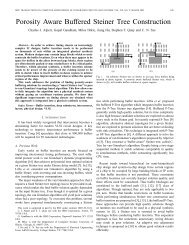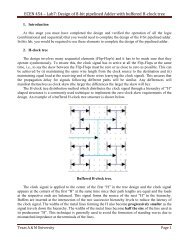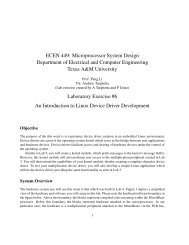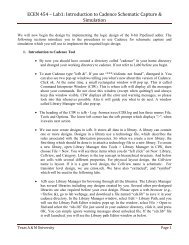Buffer Insertion Basics - Computer Engineering & Systems Group ...
Buffer Insertion Basics - Computer Engineering & Systems Group ...
Buffer Insertion Basics - Computer Engineering & Systems Group ...
Create successful ePaper yourself
Turn your PDF publications into a flip-book with our unique Google optimized e-Paper software.
the algorithm maintains two solution sets, one for positive and one for negative buffer input polarity.<br />
After choosing the best solution at driver, the buffer assignment can be then determined by a<br />
top-down traversal. The details of the new algorithm are elaborated as follows.<br />
Denote the two solution sets at vertex v by Γ + v and Γ − v corresponding to positive polarity and<br />
negative polarity, respectively. Supposed that an inverter b − is inserted to a solution γ v + ∈ Γ + v ,<br />
a new solution γ v ′ is generated in the same way as before except that it will be placed into Γ − v .<br />
Similarly, the new solution generated by inserting b − to a solution γv − ∈ Γ − v will be placed into Γ + v .<br />
For inserting a non-inverting buffer, the new solution is placed in the same set as its origin.<br />
The other operations are easier to handle. The wire insertion goes the same as before and two<br />
solution sets are handled separately. Merging is carried out only among the solutions with the same<br />
polarity, e.g., the positive-polarity solution set of left branch is merged with that of the right branch.<br />
For inferiority check and solution pruning, only the solutions in the same set can be compared.<br />
4.4 Slew and Capacitance Constraints<br />
The slew rate of a signal refers to the rising or falling time of a signal switching. Sometimes<br />
the slew rate is referred as signal transition time. The slew rate of almost every signal has to be<br />
sufficiently small since a large slew rate implies large delay, large short circuit power dissipation<br />
and large vunlerability to crosstalk noise. In practice, a maximal slew rate constraint is required<br />
at the input of each gate/buffer. Therefore, this constraint needs to be obeyed in a buffering algorithm<br />
[12–15].<br />
A simple slew model is essentially equivalent to the Elmore model for delay. It can be explained<br />
using a generic example which is a path p from node v i (upstream) to v j (downstream) in a buffered<br />
15
















